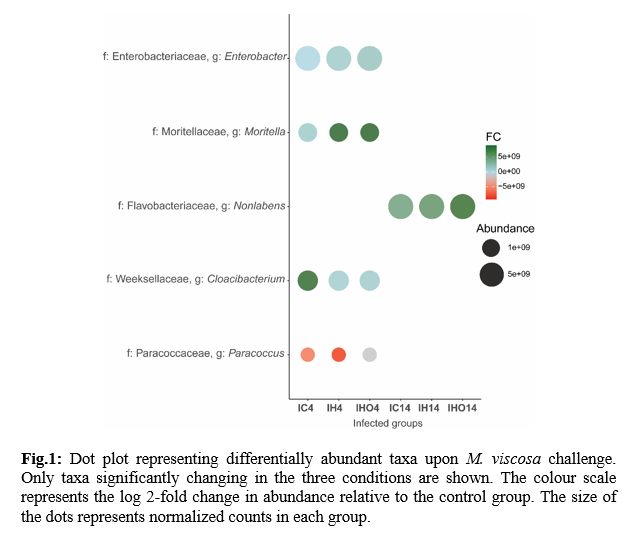AQUACULTURE UNDER CLIMATE CHANGE: HOW SKIN MICROBIOME DISRUPTION INFLUENCES WINTER ULCER INFECTION IN ATLANTIC SALMON
Introduction
The aquaculture sector’s long-term sustainability is threatened by the effects of climate change, which are not just a future, but a present reality. Changing environmental factors increase the vulnerability of Atlantic salmon to infections such as winter ulcer disease (WUD), which represents a significant challenge in salmon farming, particularly during the sea phase of production. WUD refers to the infection by the bacterium Moritella viscosa. However, other species, such as Aliivibrio wodanis and Tenacibaculum spp., have been isolated from winter ulcer outbreaks. The skin mucosal microbiome constitutes the first barrier of defence against infections by environmental opportunistic pathogens. Research concerning this field has implications for aquaculture sustainability, as shifts in microbial composition (i.e., dysbiosis) are linked to disease outbreaks. Thus, this study aimed to characterize the changes in Atlantic salmon (Salmo salar) skin microbiota when subjected to multiple climate change-related environmental stressors and infection by Moritella viscosa.
Materials and Methods
Smolts were reared under three environmental conditions for 92 days. In the first condition, fish were maintained at 12°C during the whole trial (Control “C” group). The second condition simulated a period of elevated temperatures and was repeated throughout the trial. Here, fish were maintained for five days at 12°C with a gradual increase of temperature during five days up to 17°C, then this temperature was maintained for 10 days, and after this period, it progressively declined to 12°C within 5 days. This temperature fluctuation was repeated three times (Increased temperature (heat) “H” group). In the third condition, temperature changes were maintained as in the H group, with an additional decrease in the percentage of available oxygen to 70% when water temperature reached 17°C (Increased temperature + limited oxygen “HO” group). Subsequently, all fish were transferred to two tanks in a common garden trial, and after 6 days of acclimatization, fish from one of the tanks were infected with Moritella viscosa through bath challenge (“I”). Skin mucus samples were collected after 4 and 14 days post-exposure and were analysed through ONT MinION V1-V3 16S rRNA amplicon sequencing and standard analytical pipelines.
Results
Bacteroidota was the most abundant phylum among all groups, constituting more than 29.4% of the total bacterial abundance in salmon skin, followed by Pseudomonadota (21.9%), Actinomycetota (18.7%), and Bacillota (6.9%). Interestingly, no significant differences were found in the alpha and beta diversity between the different tested conditions (C, H, HO). However, the genera Staphylococcus, Enhydrobacter, and Chryseobacterium were significantly higher when comparing the H and HO groups with the C group. On the other hand, the bacterial challenge drove significant differences in beta diversity, where several genera, including Moritella, significantly changed their abundance between the two sampling points (Fig.1). Interestingly, the abundance of this genus shifted over time, dramatically decreasing in the 14-day sampling, leading to the overgrowth of other taxa such as the genus Nonlabens from the family Flavobacteriaceae.
Conclusions
So far, the experimental infection with Moritella viscosa has provided insights into the microbial dynamics associated with WUD through time and while facing different climate change environmental stressors. Increased temperature, in combination with or without decreased oxygen levels, did not dramatically affect skin microbiota or worsen the outcome of the disease. However, these conditions facilitated the increased abundance of opportunistic bacterial taxa like Staphylococcus or Chryseobacterium. Upon infection, the microbiota in the ulcers changed from colonization by the initial pathogen, M. viscosa, to a significant overgrowth of a member of the Flavobacteriaceae family. This effect was probably due to the temperature being too high for M. viscosa to prevail, and the ulcer environment favouring the overgrowth of other more adapted genera. A deeper analysis of the microbial composition of the ulcers, their progression with time and temperature, and their functions is needed to determine the roles of key microbial players, with special focus on this microbial shift concerning Moritella and the genus Nonlabens, which has not been well described as a fish pathogen. Of note, several studies have linked a previously uncharacterized Flavobacteriaceae to infections in fish, indicating that there may be unknown pathogenic genera or species within this family that require further investigation.
Funding
Supported by: Norwegian Research Council (#194050, Insight), MSCA-ITN EATFISH (H2020 #956697), Generalitat Valenciana (CIAICO/2022/144).

